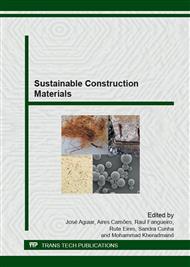p.288
p.300
p.307
p.321
p.329
p.339
p.351
p.357
p.367
Recommendations for the Construction with Adobe Brick Based on Norm NTE E.080:2000 from Peru and the Technique Currently Used in the State of Bahia - Brazil
Abstract:
The search for solutions that might promote the environmental preservation is a great challenge to be faced because of the increasingly depletion of natural resources that are used by society. To use more sustainable building material can be a way of reducing environmental damages and the generation of waste. Builds using earth have characteristics of sustainability and they are recommended in places where there is, already, the tradition of the use of this technique, once this is an abundant and propitious resource for edification. The adobe brick can contribute for a sustainable development in the civil construction if made of raw clay and if used in a large scale basis. In this article, there are presented recommendations for building that uses adobe brick, based on the Norm NTE E.080:2000 – Adobe from Peru and based on the building techniques that are adopted by constructors that use this material in the State of Bahia – Brazil At first we analyze the constructive processes that have been adopted by constructors from Bahia comparing to what Peruvian Norm professes and what can be found in the bibliography about this subject. In the end recommendations are made for the building of adobe brick in order to guarantee the effective protection and conservation of the brickwork made with this material and that provides safety and durability of edifications.
Info:
Periodical:
Pages:
329-338
Citation:
Online since:
December 2014
Keywords:
Price:
Сopyright:
© 2015 Trans Tech Publications Ltd. All Rights Reserved
Share:
Citation:


